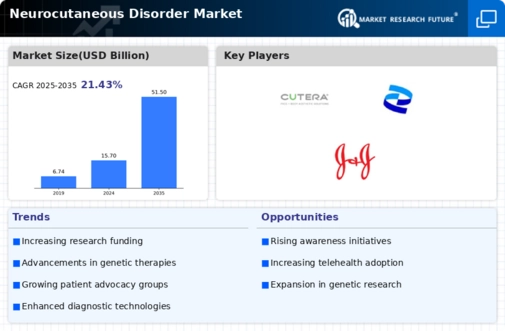Market Analysis
In-depth Analysis of Neurocutaneous Disorder Market Industry Landscape
Sturge-Weber syndrome (SWS), also referred to as encephalotrigeminal angiomatosis, is an infrequent neurocutaneous syndrome distinguished by cutaneous Port Wine Stains (PWS), ocular irregularities, and neurological complications. The National Organization of Rare Disorders reports that approximately 3 in 1,000 infants are born with a port-wine birthmark, but merely 6% of this population develops the neurological abnormalities associated with Sturge-Weber syndrome.
This complex condition manifests as phakomatosis, featuring distinctive traits like Port Wine Stains, abnormalities in the eyes, and neurological challenges. While cutaneous Port Wine Stains are a common occurrence, the intricate connection between these birthmarks and the subsequent development of neurological complications is a defining characteristic of Sturge-Weber syndrome.
Globally, healthcare systems are evolving in response to an array of factors, including advancements in medical technology, the emergence of new health services, shifts in health policies, the implementation of novel organizational structures, innovations in drug development, and the broader accessibility of health services. The dynamic nature of these influences contributes to the ongoing development and transformation of health systems on a global scale.
As medical technology continues to advance, health services are adapting to integrate these innovations, leading to a paradigm shift in the landscape of healthcare delivery. The incorporation of cutting-edge medical technologies facilitates enhanced diagnostic capabilities, innovative treatment modalities, and improved patient outcomes. Moreover, the introduction of new health services addresses evolving healthcare needs, providing a more comprehensive and patient-centric approach to medical care.
Changes in health policies further shape the trajectory of healthcare systems, influencing areas such as funding, accessibility, and the overall organization of healthcare delivery. Policy adjustments are pivotal in aligning healthcare systems with contemporary healthcare challenges and societal needs. These modifications contribute to the optimization of healthcare resources, fostering more efficient and equitable healthcare delivery.
In parallel, the restructuring of organizational frameworks within healthcare systems seeks to enhance efficiency, collaboration, and overall effectiveness. The evolution of organizational structures reflects a strategic response to the demands of a rapidly evolving healthcare landscape. The aim is to create systems that are resilient, adaptable, and capable of meeting the diverse healthcare needs of populations.
The pharmaceutical landscape is witnessing significant innovation, with ongoing developments in drug discovery and development. Novel therapeutic approaches, precision medicine, and breakthrough treatments are reshaping the pharmaceutical industry. These innovations not only expand the scope of available treatment options but also contribute to advancements in personalized and targeted therapies.
Greater accessibility to health services is a key focus of global healthcare initiatives. Initiatives aimed at improving healthcare access play a crucial role in addressing health disparities, ensuring that individuals, regardless of geographical location or socio-economic status, can avail themselves of essential healthcare services. This inclusivity is fundamental to achieving global health objectives and promoting health equity.
In conclusion, Sturge-Weber syndrome presents a complex medical condition that underscores the importance of continuous advancements in healthcare systems. The interplay of factors such as technological innovation, evolving health services, policy dynamics, organizational restructuring, pharmaceutical breakthroughs, and enhanced accessibility collectively contributes to the dynamic evolution of global healthcare. As healthcare systems adapt to these multifaceted influences, they are better positioned to address the complexities of conditions like Sturge-Weber syndrome and meet the diverse healthcare needs of populations worldwide.






Leave a Comment